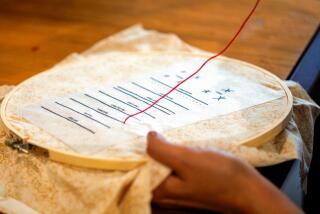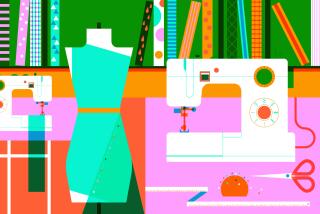A Machine Tailored to Serious Sewers
- Share via
I can’t tell whether the Husqvarna Viking Designer I is a sewing machine trapped inside a computer or a computer trapped inside a sewing machine. Either way, it’s the best unlikely combination since peanut butter met chocolate.
I know more about computers than sewing machines, but my mother--who sewed the jumper I wore to my first day of school--fell in love with the Designer I almost instantly. Within 15 minutes of examining its special features, she gushed, “This is very cute. I’m going to want this.”
Alas, her desire will go unfulfilled. At $5,699, the price is right only for absolute sewing fanatics. Other companies make similarly sophisticated--and expensive--machines. Bernina’s Artista 180E, for example, retails for $4,599. But the Designer I has consistently earned the top rating for a sewing machine from enthusiasts at Epinions.com.
“The Designer 1 is a dream to sew and embroider on,” one fan wrote. “It can be addicting.”
Watching the needle wind its way around a piece of fabric as it stitches a colorful floral pattern or spells out a monogram can indeed be mesmerizing. But as far as I’m concerned, the best thing about the Designer I is that you don’t have to watch it. My idea of the perfect sewing machine is one that lets you watch a baseball game while it does all the stitching.
Befitting its PC heritage, the Designer I took a considerable amount of fiddling to get it to work smoothly. Mom and I tangled threads, puzzled over the correct way to mount an embroidery loop, frequently got stuck in the on-screen menus and even broke a sturdy sewing needle. But in an entire day of sewing, we could trace nearly every misplaced stitch back to a human error.
As a pure sewing machine, the Designer I seems perfect. The folks at Husqvarna Viking must have interviewed hundreds of serious sewers and listened to their suggestions. Many of the special touches were lost on me, but my mom noticed them right away.
For instance, when the machine stops sewing, it automatically leaves the needle in the fabric so it won’t slide around. My mom’s sewing machine forces her to do this by hand.
The Designer I offers two ways to wind thread onto a bobbin, neither of which requires the sewer to remove the spool for the top-stitch thread or to unthread the needle. One method fills the bobbin with the same thread used for the top stitching. The other uses a separate spool pin so the bobbin thread can be different.
My mom’s favorite feature was the button for automatic thread cutting. Not only will the Designer I cut the top and bottom threads for you before you pull the fabric away from the machine, it will even push the top thread through to the bottom side so there are no loose ends on the front.
There were some things even I could appreciate.
The base of the sewing machine has a built-in accessory tray with compartments for storing extra bobbins, needles, presser feet and other items. The 12 function buttons on the front allow you to sew in cruise-control mode so you can start, stop, speed up, slow down and change sewing direction without using the foot pedal. There’s even a ruler printed on the bottom of the machine for making quick measurements.
Husqvarna Viking also included a 3 1/2-by-4 3/4-inch color screen on the front of the machine and a 3 1/2-inch floppy disk drive on the side. The touch screen guides users through the 600 kinds of stitches, 19 kinds of button holes and three alphabet fonts built in to the Designer I. It also links users to their custom list of favorite stitches.
The Designer I employs the screen to impart its wisdom. The “sewing advisor” along the bottom lets you select a sewing technique (such as seam, hem or button) or a fabric type (woven, stretch, leather or vinyl) and suggests which stitch, needle and presser foot to use for the task.
Pressing the “help” tab in the upper-right-hand corner calls up recommendations on when to lower feed teeth, stabilize the fabric, cord buttonholes and the like.
What truly sets the Designer I apart, though, is the embroidery unit, which snaps onto the base of the machine. The embroidery arm shifts back and forth and the hoop attachment glides up and down, allowing the needle to reach any point on a piece of fabric.
It took a few tries to get the fabric correctly positioned in the hoop, and stretchy garments such as T-shirts can offer a particular challenge. Once I got the hang of it, I could load it up without diverting my attention from a close game in extra innings.
The part that required full attention was selecting a design to embroider. The machine comes with a set of disks that includes designs of flowers, vines, animals, bugs and alphabets in three fonts. (More designs are available on other disks, sold separately.) Thumbnail images appear in full color on the screen, and they can be enlarged to show greater detail with a finger tap.
Daring users can modify the designs to make them as much as 20% longer, shorter, wider or more narrow. The designs also can be flipped or rotated and moved around within the embroidery space. Starting with a single design of three long-stemmed daisies, for instance, a user could create a full bouquet.
I combined the words “Tech Times” with a pair of vines intertwined with ribbon. The machine allowed me to stretch the vines in one direction and shrink them in another, then position them on opposite corners of the words.
Figuring out the exact order of buttons to press to make all my selections involved considerable trial and error. Waiting for my selections to slowly make their way onto the screen required a fair amount of patience.
Once my design was set, however, the machine took charge. In a series of dialogue boxes on the screen, the Designer I instructed me where to snap in my embroidery loop, when to snip off the thread tail and when to change thread colors.
Otherwise, it went on auto pilot. The screen provided almost real-time updates on where the needle was in the pattern and how many stitches were remaining. The machine let out a beep when it needed my attention, such as when a thread broke or when I needed to change colors. In the meantime, my mom and I watched our beloved Seattle Mariners wrap up a come-from-behind victory against the Cleveland Indians.
The only PC-like glitch occurred about 50 minutes into the embroidery, when the Designer I began stitching the second of my two vines. For some reason we could never discern, the machine insisted on sewing the vine on top of the word “Tech,” even though the screen showed the needle a good distance from the letters.
After some tedious stitch-ripping, I set the hoop back in the proper position. Before I started again, I took advantage of a clever feature that lets the user see a dry run of where the needle intends to go, using “+” and “-” buttons to fast-forward and reverse. Once again, the needle was veering from the design on the screen.
Perplexed, I reverted to the tried-and-true solution for dealing with temperamental PCs: I shut the thing off and rebooted.
That meant I had to reprogram my design from scratch. (If I’d had a PC disk handy, I could have saved my design first.) This time it worked like a charm. I even restitched part of the “T” that got ripped out along with the errant stitches. Though it didn’t match up perfectly, it was impressively close.
The Designer I does an excellent job with lettering, and my mom took advantage by monogramming a few of her homemade quilts. We weren’t too keen on most of the patterns, which were a little too kitschy.
For those who feel the same--and who have some spare cash sitting around--Husqvarna offers a $1,999 software package called Digitizing Embroidery System 5 that converts any digital picture--photograph, scanned freehand drawing or any image from the World Wide Web--into a pattern for embroidery or cross-stitching. Once saved onto a disk, it works just like any other pattern.
Although the Designer I’s computer-generated embroidery and fancy stitches are impressive, I couldn’t help feeling that something was missing. These perfect needle crafts don’t have the same homemade quality as the ones my mom and her mom made for me when I was a little girl.
*
Times staff writer Karen Kaplan covers the Internet.
More to Read
Inside the business of entertainment
The Wide Shot brings you news, analysis and insights on everything from streaming wars to production — and what it all means for the future.
You may occasionally receive promotional content from the Los Angeles Times.











